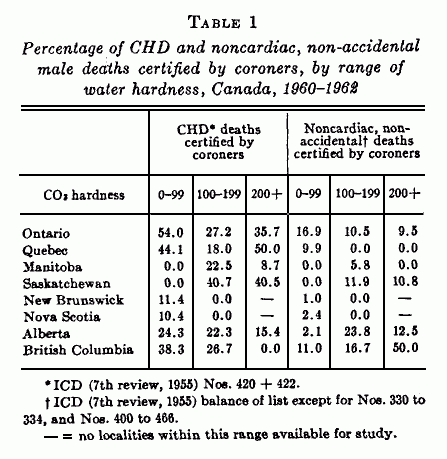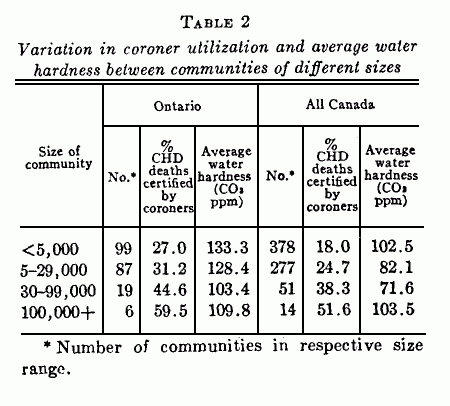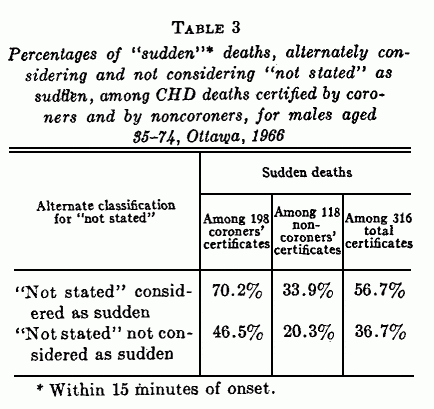American Journal of Epidemiology, Vol. 94 August, 1971 No.
2
ORIGINAL CONTRIBUTIONS
RISK OF SUDDEN DEATH IN SOFT WATER AREAS
L. C. NERI,1 D. HEWITT2 AND J. S.
MANDEL1
(Received for publication December 22, 1970)
Abbreviation: CHD, coronary heart
disease.
1Dept. of Epidemiology and Community Medicine,
University of Ottawa, Ottawa, Ontario, Canada.
2School of Hygiene, University of Toronto, Toronto,
Ontario.
This research was supported in part by grant #605-7-609 from the
Department of National Health and Welfare, Federal Government,
Canada.
Neri, L. C. (Dept. Epidemiology and Community
Medicine, University of Ottawa, Ontario, Canada), D. Hewitt and
J. S. Mandel. Risk of sudden death in soft water areas.
Amer J Epidem 94: 101-104, 1971.—This paper
continues discussion of a reported association between
suddenness of death from coronary heart disease and residence
in soft water areas. An attempt has been made to establish, for
the city of Ottawa, the extent to which coroner-certified
deaths correspond to a classification of sudden/nonsudden. It
is suggested that the predictive value of water hardness may be
related to trace metal contents.
arteriosclerosis; coronary heart disease; death, sudden;
epidemiology; water supply
It is widely recognized that coronary heart disease (CHD) is
not, from the epidemiologic point of view, a single entity. For
example, both cigarette smoking and physical inactivity (1) have
been shown to relate mainly to the risk of sudden death from CHD
rather than to the risk of more chronic forms of the disease. It
was recently suggested by Anderson (2) that excess CHD mortality
of residents in soft water areas may also take the form of sudden
death. The basis for this suggestion was a statistical analysis
of deaths occurring during 1967 in the Province of Ontario whose
counties had, for the purpose of the study, been grouped into
three ranges of average water hardness. Separation of sudden from
nonsudden deaths was made on the basis of whether or not the
death certificate was signed by a coroner. The reason for using
the coroner/noncoroner classification was simply one of
convenience as it can be determined from machine-readable
records, whereas the more direct indications of suddenness can
only be retrieved by search of the original death certificates.
It was shown that, during 1967, the percentage of certificates
signed by a coroner was highest (47 per cent) in the counties
with softest water, and lowest (33 per cent) in those with the
hardest water. No comparable trend was detected for other causes
of death, the percentage of coroners' certificates being 17 per
cent in soft water counties and 14 per cent in hard water
counties.
Selected items of information concerning all deaths of
Canadian residents are retained on magnetic tape in Ottawa.
Copies of the tapes for 1960, 1961 and 1962—containing no
individual identification—were kindly provided by the Vital
Statistics Section of the Dominion Bureau of Statistics. They
have been sorted by age, sex, residence and certified cause of
death to obtain numerators for mortality rates based on 1961
Census populations. An interim report of this study has already
been presented (3) and fuller details will appear elsewhere. We
are concerned here only with data corresponding to those analyzed
by Anderson (2). Our units of study were individual
municipalities (all having a municipal water supply) of which
there are over 200 in Ontario, compared to only 54 counties, and
which therefore offer a better means of separating out the
populations exposed to water of different degrees of hardness.
Table 1 shows, for the three years 1960-1962, the percentage of
coroners' certificates among all certificates citing CHD as the
underlying cause of death of male residents in municipalities
whose water supplies fell into each of three ranges of hardness.
As was previously found by Anderson, this percentage is
appreciably higher (by a factor of 1.5) for the soft water areas
in Ontario (<100 ppm), than for the hard water areas (>200
ppm), but the figure for the intermediate range of hardness,
instead of falling between the values for hard and soft water
areas, here shows as the lowest of the three. A more important
difference between the present figures and those previously
reported is that the percentage of coroners' certificates among
all certificates citing other causes of death (noncardiac,
non-accident) is also appreciably higher (by a factor of 1.77) in
soft than in hard water areas. Thus the Ontario correlation
between soft water and a high percentage of death certificates
signed by a coroner probably has to be explained in terms more
general than those of any postulated relationship between soft
water and the risk of sudden death from CHD. A likely partial
explanation is that in Ontario, as in Canada generally, average
hardness and coroner utilization rates are both related to size
of community.

Anderson had it in mind to counter this possible explanation
for his findings when he showed that similar results could be
obtained from the 1967 figures with or without the inclusion of
cities over 100,000. However, as table 2 shows, this exclusion
does not suffice to remove the confounding effect of community
size.

Interpretation of figures based on a single year or a period
as short as three years is made difficult by the fact that
utilization of coroners' services in Ontario (and Canada) has not
remained steady over the years. Though the general level appears
to have been much the same in 1967 as it was during 1960-1962, we
know that as recently as 1950-1952 the percentage of coroners'
certificates was lower by more than a half.
Another interpretative problem arises from uncertainty
experienced by various investigations (4) about the extent to
which a classification of certificates as coroners/noncoroners
corresponds to any classification as sudden/nonsudden. We were
able to test this in Ottawa for the year 1966.
Out of 2,500 death certificates reviewed, there were 316 male
deaths at ages 35-74 that fell in the category 420 + 422 (CHD).
Statistical evaluation is complicated by the fact that a
proportion of certificates contained no statement concerning the
interval between onset and death, but clearly the frequency of
sudden death defined here as within 15 minutes of onset, in this
group could not be less than 0 per cent or more than 100 per
cent. Applying each of these extreme assumptions in turn, it can
be computed from the figures in table 3 that a coroner-certified
death from coronary disease was 2.1 to 2.3 times as likely to
have been "sudden" as one certified by a noncoroner. Compared
with coronary deaths as a whole the relative likelihood that
coroner-certified death would have been sudden was only about 1.2
to 1.3.

In the opinion of the present writers, the Ontario statistics
so far examined, taken as a whole, hardly sustain
Anderson’s hypothesis. Nevertheless, because it appeared to
us that this hypothesis had heuristic value, we analyzed data
from seven of the nine other Provinces [Newfoundland had no
coronary deaths certified by a coroner during the entire period
1966-1962, while in Prince Edward Island only two localities were
available for the study.] in the hope that some research leads
would emerge (see table 1). In three of these (Quebec, Manitoba,
Saskatchewan), communities within the softest range showed a
lower percentage of coroners’ certificates than one or both
of the relatively hard water groups. In the two Atlantic
Provinces studied, coroners did tend to certify more of the CHD
deaths of residents in soft than in hard water areas, but the
level of coroner utilization was so low that it was impossible to
judge whether this tendency was characteristic of CHD in
particular or whether, as in Ontario, it applied to deaths in
general. There remain the two westernmost Provinces (Alberta,
British Columbia), in each of which the percentage of "coroners'
coronaries" followed the pattern noticed by Anderson in the 1967
Ontario figures, and in each of which, most satisfactorily, the
corresponding percentages for other causes of death exhibited a
contrasting arrangement. Could it be more than a coincidence that
the report by Peterson et al, (5) is based on data collected in
an area of the United States adjacent to British Columbia? These
workers set out to reproduce Anderson's results as closely as
possible, using the same ranges of water hardness, and the same
criterion of sudden death. When this failed, they substituted
another criterion (died at home or dead on arrival at hospital)
that was believed, under Washington conditions, to provide a
stronger presumption of sudden death than did certification by a
coroner. On this basis, they felt they were able to demonstrate
an association of the type sought. Yet, on examining their
findings, it can be seen that the contrast between water hardness
ranges was much greater for sudden deaths not attributed to
arteriosclerotic heart disease (ASHD) (mortality ratio of 1.5)
than for sudden deaths that were attributed to ASHD (mortality
ratio of only 1.1). Hence if the phenomenon reported by Peterson
et al. is a genuine one at all it certainly cannot be regarded as
something related to ASHD in patients. Also, it is important to
note that Washington State has no very hard water (>200 ppm)
and therefore comparisons have to be made between only two ranges
of water "softness". This guaranteed the authors at least a 50:50
chance of obtaining qualitative agreement with any earlier
findings.
The percentage of deaths certified by coroners is, of course,
a "proxy variable" whose validity as an index of the frequency of
sudden death in different areas cannot be assumed without local
knowledge. In all likelihood, hardness of water is another such
variable, whose predictive value depends on the degree to which,
in a particular geologic setting, hardness correlates with the
presence or absence of some water constituent having real
physiologic significance. Our statistical analyses, to be
reported in detail elsewhere, suggest that in Canada generally,
water hardness does not have the value as a predictor of CHD
mortality rates that it has been shown to have in the United
States, England, etc. (6-10). We have therefore launched a
nation-wide collection of water samples and are making
determinations of a number of trace elements, among which (in
view of the recent report by Voors (11)) we now propose to
include lithium as well as chromium, zinc, copper, cadmium,
molybdenum, vanadium and magnesium.
REFERENCES
1. Kannel WB, Castelli WP, McNamara PM: The coronary profile:
12-year follow-up in the Framingham Study. J Occup Med, 9:
611-619, 1967
2. Anderson TW, le Riche WH, MacKay JS: Sudden death and
ischaemic heart disease. New Eng J Med 280: 805-807, 1969
3. Neri LC, Mandel JS: The relationship between water hardness
and cardiovascular mortality in Canada (an interim report).
Presented at the Society for Epidemiological Research,
Minneapolis, USA, June 1970
4. Kuller L: Sudden and unexpected non-traumatic deaths in
adults: A review of epidemiological and clinical studies. J Chron
Dis 20: 1165-1192, 1967
5. Peterson DR, Thompson DJ, Nam J: Water hardness,
arteriosclerotic heart disease and sudden death. Amer J Epidem
92: 90-93, 1970
6. Schroeder HA: Relation between mortality from
cardiovascular disease and treated water supplies: Variations in
states and 163 largest municipalities of the United States. JAMA
172: 1902-1908, 1960
7. Morris JN, Crawford MD, Heady JA: Hardness of local
water-supplies and mortality from cardiovascular disease in the
county boroughs of England and Wales. Lancet 1: 860-862, 1961
8. Biorck G, Bostrom H, Widstrom A: On the relationship
between water hardness and death rate in cardiovascular disease.
Acta Med Scand 178: 239-251, 1965
9. Schroeder HA: Municipal drinking water and cardiovascular
death rates. JAMA 195: 81-85, 1966
10. Crawford T, Crawford MD: Lead content of bones in a soft
and hard water area. Lancet 1: 699-701, 1969
11. Voors AW: Lithium in the drinking water and
atherosclerotic heart death: Epidemiologic argument for
protective effect. Amer S Epidem 92: 164-171, 1970
This page was first uploaded to The Magnesium Web Site on
September 30, 2002
http://www.mgwater.com/



